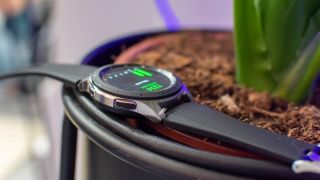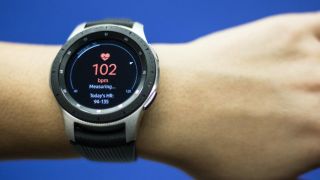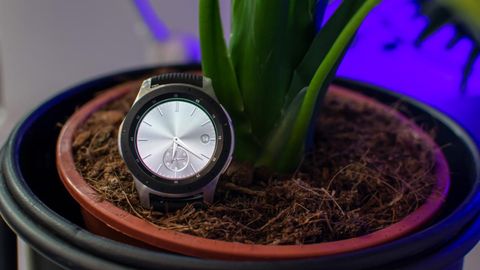Our Verdict
The Galaxy Watch is gorgeous to look at and seems great on paper, but it all goes downhill when you actually try to use it. There aren’t many apps, the sports tracking is poor, the heart rate tracking is dreadful and the quoted battery life verges on the misleading. It’s a decent smartwatch with great every activity tracking and 4G capabilities if you’re on EE, but we couldn’t help feeling disappointed.
For
- Fantastic screen
- Rotating bezel for navigating functions
- Activity tracking
- Music is well integrated
Against
- Heart rate tracking inaccurate
- The native run tracking is basic
- Battery life
You can trust Coach
Samsung Galaxy Watch In-Depth
Using The Samsung Galaxy Watch To Track Activity
Samsung has thrown everything at the wall when it comes to tracking your everyday activity – and no doubt attempting to get into our list of the best fitness trackers – with easy-to-access widgets on the Galaxy Watch which show your steps, active calories, floors climbed, stress, water and caffeine intake, and even record calories eaten. All of these widgets look smart and it’s simple to see daily stats as well as data for the past week, and if you don’t want to scroll through all the individual stats there’s a widget to show the standard set of stats on calories, steps, floors climbed and heart rate. You can also adjust your targets in the partner app and on the Galaxy Watch itself.
I’m a sucker for a clever widget and I was impressed by the activity tracking on the Galaxy Watch. For me it’s a mark of a well-designed smartwatch if you never have to use the app to check on your basic activity stats, and that’s certainly the case with the Galaxy Watch, which displays all the info you want clearly and colourfully.
The device will notify you if you’ve been sedentary for too long by telling you to do some torso twists, a novel alternative to the standard “get up and move” notifications you get from most trackers, although I’m unsure if torso twists are as good a way to break up a long stretch of sitting as walking around for a couple of minutes is.
Running With The Samsung Galaxy Watch
The Galaxy Watch is a smartwatch first, a fitness tracker second and a sports tracker third, so I’m prepared to go easy on it, but even so the native run tracking capabilities of the watch are poor. It seems like runners weren’t let anywhere near the design of the Galaxy, leading to bizarre decisions like having no average pace stat available, only current pace.
Average pace is not some niche stat that only obsessive runners will want – it’s probably only second to time and distance in terms of importance, especially as current pace jumps all over the place when using the Galaxy to the point where it’s largely unusable (as it does with many GPS trackers, to be fair). Also, it can show only three stats on screen during a run, though you do get three customisable data screens.
One thing I was excited about was that the Watch has an always-on screen, which is very useful for running and cycling when you don’t want to raise it all the way to your face to see your stats. However, the always-on screen only shows the main watch face, not the running screen, so you have to raise it anyway to get your stats. This could have been a great differentiator to the Apple Watch, which has no always-on option, but the Galaxy Watch is just as useless on this front during workouts.
You can set a target for your run, based on time, distance, calories or one of Samsung’s Pace-setter workouts, which range from light jogging to intense speed endurance sessions. You can also create customised sessions in the Samsung Health app, if the standard targets don’t match up to your running ability.
Strava was not initially available as an app when I got it to review, but it’s now in the app store, and it offers better run tracking (including average pace) than the native option on the watch. You can also use other third-party running apps like Endomondo and I would urge you to do so – Samsung’s tracking isn’t up to snuff.
However, whatever app you choose you are stuck with the heart rate monitor, which was inaccurate most of the time, even when not exercising. During runs I found it often didn’t record at all. I tried moving the Galaxy Watch up and down my arm, tightened and loosened the band, but it was never consistently accurate. Don’t rely on it as a way to judge the intensity of your running workouts.

Working Out With The Samsung Galaxy Watch
The Galaxy Watch is advertised as having 39 different sports modes, which seems like a lot until you clock that individual exercises like the bench press or arm extension are categorised as modes. This is, however, one of the best sports tracking features on the watch, because you can record individual exercises in the gym, with reps tracked by the watch automatically, and link them together into a workout that’s then broken down by exercise.
Naturally, the Galaxy Watch can’t include every possible gym exercise, but all the main ones are there, so you can get a more comprehensive breakdown of your workout than is available on any other tracker I’ve tried. And if you can’t be bothered to fiddle with the watch when changing between exercises, there are also general circuit training, weight machine and other workout settings available.
It would be great to be able to set up intervals for a custom workout to guide you through your work and rest periods, but I couldn’t see a way to do this for any of the sports modes on the Galaxy Watch. There are some paid apps available that offer this functionality, but it’s a basic thing that should be native to any wearable with fitness tracking aspirations.
Cycling With The Samsung Galaxy Watch
As with running, the native cycle tracking on the Galaxy Watch is pretty basic and suffers from the same lack of an always-on screen for your stats as run tracking. Strava and Endomondo are better, though you can also sync Samsung workouts to Strava (if you are using the Galaxy Watch with a Samsung phone; this currently isn’t possible if it’s linked to an iPhone).
Again, the heart rate tracking is consistently inaccurate when cycling. On one ride my average was recorded as 130, which put most of the ride in the vigorous exercise category when it was anything but. The correct heart rate hovered between 80-100 throughout the ride (a very easy commute). This not only means the heart rate stats for the ride are useless, but also throws off calorie and active minutes stats.
Swimming With The Samsung Galaxy Watch
Although the excellent Speedo On app was not available at the time of reviewing (it is on the Gear Fit2 Pro, so it could come to the Galaxy Watch in time), this is still a device that does well in the pool – far better than for other sports. During your swim you can see stats like strokes, lengths and pace per 100m, and the watch will buzz when you complete a length to let you know it’s been marked.
The Galaxy Watch also attempts to record your heart rate in the water. Given that it can’t really do that accurately out of the water, it’ll be no surprise to learn it isn’t very successful in this regard. Once you’ve finished you get a breakdown of lengths including the stroke type used in the app, along with your pace and SWOLF score.
There are a couple of problems though: one minor – you can’t pick a pool length under 20m; and one major – no open-water swimming tracking. It’s waterproof and has GPS, so I’m not sure why Samsung hasn’t made this an option on the Galaxy Watch, especially when it is on the Apple Watch.
Heart Rate Tracking On The Samsung Galaxy Watch
Not good, as you may have gathered from the above. Most wrist-worn monitors struggle a bit when you’re working out at a high intensity, but none that I’ve come across have failed to take an accurate reading when I’m just sitting at my desk. It could be because the Galaxy Watch is quite bulky and my wrists are quite skinny, but I’ve tried heart rate trackers from almost every brand and never had such issues. I’m going to go ahead and say be wary of the Galaxy Watch if heart rate tracking is an important feature for you.
Click on the heart rate widget and you’ll get details of your heart rate range for the day, along with time spent exercising vigorously and moderately, and at your maximum. You can also see your resting heart rate range. All of this relies on it working properly, though, so I quickly started to ignore all these stats.

Listening To Music On The Samsung Galaxy Watch
Get the 4G version, link it to your Spotify account and it’s happy music-filled days. You have everything you could ever want in terms of streaming music on the Galaxy Watch even if your phone is miles away. You can also load it with your own music if streaming isn’t your bag, and it links well to Bluetooth headphones, even those not made by Samsung. Top marks here.
Sleep Tracking On The Samsung Galaxy Watch
One of the benefits of the purported seven-day battery life on the Galaxy Watch is that you can use it for sleep tracking, which is done automatically by the watch. A major boon compared to the Apple Watch, which needs to be charged each night. Unfortunately, so does the Galaxy Watch, so you can choose to use it for sleep tracking then charge it in the day, or plug it in at night.
If you do opt to wear it while you sleep you get a breakdown of your night’s rest in the morning that shows the time spent in light, deep and REM sleep, along with any periods when you are awake. It’s hard to judge how accurate these things are, but I’d question the suggestion I only spent nine minutes in deep sleep one night and zero minutes the next considering I woke up feeling well rested both mornings.
The reason I only wore the Galaxy Watch for two nights to check out the sleep functions is partly because of the battery, but also because it’s a fair old lump to have on your wrist all night long. It’s not especially uncomfortable, but if I really did manage only nine minutes of deep sleep across two nights maybe it was because of the absolute unit strapped to my wrist.
The Samsung Galaxy Watch’s Smartwatch Features
The 4G version of the Galaxy Watch (available only on EE) allows you to completely untether from your phone while still being able to receive and respond to calls, texts and emails, as well as stream music (including via the Spotify app). The Galaxy Watch also has Samsung Pay, so it can replace your wallet as well as your phone, especially as there are many more participating banks than on Fitbit Pay or Garmin Pay.
It’s a smart smartwatch then, and well ahead of more fitness-focused smartwatches like the Fitbit Ionic or Garmin Vivoactive 3. However, it is lacking in apps compared with the Apple Watch and other Wear OS options, owing to the fact Samsung uses its own operating system. The app market should fill out, with Strava arriving recently as an example, but this is certainly one area where Apple and Wear OS devices have a massive advantage.
How Often Am I Going To Have To Charge It?
Seven days, says Samsung. Every day, say I. You may be able to push it to two days, but it really would be pushing it if you’re normally using the Galaxy Watch to track GPS activities, and especially if you’re listening to music at the same time.
It’s the biggest disparity I’ve come across between quoted battery life and real-world performance. If you turn off the heart rate tracking and always-on screen, as well as dimming the screen and never using GPS tracking, you could probably stretch it for five days or more, but why buy a top-end smartwatch and then not use its features?
This has annoyed me greatly, because I’d guess part of the reason for the “seven days” claim is to outshine the Apple Watch’s maligned one-day battery life. But the Samsung Galaxy Watch didn’t last any longer than the Apple Watch I was wearing at the same time. In fact, I found the latter would have more juice left at the end of a day when I’d used both in the same way, except with the Galaxy Watch always-on screen feature turned on.
One day of battery life is not great, but the Galaxy Watch is a very smart bit of kit that does an awful lot, so I’m OK with charging it every day – just don’t claim it’s going to last a week.
Where Can I Wear It Without People Laughing At Me?
Everywhere. This is one of the most attractive smartwatches out there, especially if you opt for one of the gorgeous analogue displays. You can get silicone, canvas and leather straps for the Galaxy Watch, with the first of those trio being the best option for exercise.
Should I Consider Buying Something Else?
If you’re an iPhone owner the easy answer is yes. The Samsung Galaxy Watch works with iPhones but the Apple Watch Series 4 is better integrated and just a better smartwatch to boot. You can also get a 4G version of the Apple Watch, though the one big edge the Galaxy Watch has is a Spotify app for streaming music on the go, while you’ll need to be an Apple Music subscriber to get the same service from the Apple Watch.
Whether the Samsung Galaxy Watch is the best pick for you if you’re an Android user depends on what you’re planning to do with it. If you’re very sporty then it probably won’t cut the mustard – a fitness watch with some smart features like the Fitbit Ionic or Garmin Fenix 5 Plus will be a better pick. If you’re all about everyday activity tracking and want the smartest computer possible on your wrist, then the Galaxy Watch is a good option, though the unreliable heart rate tracking could still prove annoying.

Nick Harris-Fry is a journalist who has been covering health and fitness since 2015. Nick is an avid runner, covering 70-110km a week, which gives him ample opportunity to test a wide range of running shoes and running gear. He is also the chief tester for fitness trackers and running watches, treadmills and exercise bikes, and workout headphones.

